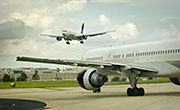
Insurance Coverage Considerations for Unmanned Aircraft Systems
On February 23, 2015, the Federal Aviation Administration ("FAA") issued new proposed regulations for the operation and certification of small unmanned aircraft systems ("sUAS"), popularly referred to as "drones."[1] Although the proposed rules do not require that sUAS operators obtain liability insurance coverage, FAA-approved sUAS operations will create myriad potential liability issues for sUAS owners, operators, and manufacturers. Unmanned aircraft have potential utility in a multitude of commercial settings, including monitoring crops, weather, pipelines, power lines, and construction; evaluating insurance claims; and aiding in disaster management, law enforcement, telecommunication, aerial imaging and mapping, news coverage, and package delivery. The economic impact of the total integration of commercial UAS into the national airspace has been estimated at $13.6 billion in the first three years.[2]
But there are many risk factors associated with unmanned aircraft—lost, delayed, or distorted operating signals, failure of power systems, software errors, susceptibility to hijacking and "spoofing," and midair collisions with other aircraft, to name a few—that could cause property damage, bodily injury, and other kinds of liability.[3] Those involved in this emerging market should understand the risks the many uncertainties of commercial sUAS operation pose, as well as consider insurance coverage implications for sUAS-related liability.
Potential Liability Risks Posed by UAS
sUAS operation poses different risks to different actors. Individuals, businesses, and other commercial entities that own and operate unmanned aircraft are exposed to the widest variety of risk. sUAS owners may be exposed to potential liability for damage their unmanned aircraft could cause to their business—damage to the aircraft themselves from malfunctions or crashes, damage to business property, and personal injury to employees, as well as loss of use, replacement costs, and business interruption if aircraft are irrevocably damaged and must be replaced. Owners could also be liable for damage their sUAS cause to others, including property damage, personal injury, and business interruption. Owners may even be exposed to negligence claims in operation or hiring, training, and supervising sUAS operators and support personnel, including visual observers and maintenance providers.
Other potential liability concerns for owners involve software corruption and invasion of privacy risks. Many unmanned aircraft are capable of collecting, storing, and even sending data in real time to ground stations. sUAS are often equipped with onboard cameras or infrared sensors. Operators may therefore either intentionally or inadvertently capture or transmit personal, nonpublic information, such as intellectual property, trade secrets, and other confidential data. sUAS software can be hacked, or "spoofed," to gain control over the sUAS and sensitive data it has collected. These possibilities open owners up to potential liability for a wide variety of invasion of privacy and media liability torts resulting from misuse, corruption, or hacking.
sUAS owners and operators are not the only actors exposed to potential liability. Because of the speculative nature of commercial sUAS operations and the many complex components that an sUAS contains (software, power systems, wings or rotors, parachutes and other landing systems, etc.), sUAS manufacturers, as well as manufacturers of sUAS components and software, will likely face a glut of product liability issues and claims as the industry grows. Manufacturers should be prepared for claims alleging design and manufacturing defects, inadequate warnings, breach of express and implied warranties, and failure to comply with sUAS safety standards, which are sure to evolve as the industry expands.
The Emerging UAS Insurance Market
The market for UAS-specific insurance coverage is already developing. In addition to what traditional commercial general liability policies may already cover, the Insurance Services Office has drafted specific UAS endorsements for potential use in commercial liability policies, scheduled to be available in June 2015.[4] Those endorsements may either enhance or alter coverage for the types of claims referenced above. Insurers with experience in aviation specialty risks are expected to take the lead in writing specific coverage. Last year, AIG unveiled a stand-alone Unmanned Aircraft Insurance program, providing physical damage and third-party liability coverage, with policy language "drafted specifically to respond to the exposure of unmanned aircraft."[5] The coverage includes UAS operators and crew members on the ground as insureds. Because electronic issues are a common cause of UAS crashes and damages, the policy is marketed as including coverage for loss arising from electronic malfunctions and failure of electronic components, accessories, and power equipment, unlike standard aviation insurance. AIG also provides optional coverage for hijacking or "any unlawful seizure or wrongful exercise of control by means of 'spoofing.'"
In addition to its stand-alone policy, AIG has developed a separate Unmanned Aircraft Liability Endorsement to its CGL policy, but only for UAS weighing up to five pounds with wing or rotor spans of less than three feet.[6] AIG's separate endorsement is likely to be of most value for a subclass of UAS termed "micro-UAS" by the FAA's proposed regulations. Micro-UAS are those UAS weighing 4.4 pounds or less and made of frangible materials that will break, distort, or yield upon impact. The FAA's proposed regulations governing micro-UAS are intended to recognize the reduced risk these micro-UAS pose and regulate them accordingly.[7]
Allianz has marketed stand-alone UAS coverage in Australia and includes a form UAS policy on its website, which provides broad first- and third-party coverage but purports to exclude losses due to operations by nonapproved pilots, conducted outside approved landing and takeoff areas, and caused by hijacking.[8]
The specialized loss coverage and exclusions in these various policies and endorsements provide a window into viewing how insurers are beginning to assess UAS-related risks and market insurance products accordingly. Because unmanned aircraft pose a variety of risks about which there is little information in the commercial operation context, insurance companies will likely require greater detail about planned UAS activities in the underwriting process. A recent European Commission study on third-party liability and insurance requirements for unmanned aircraft recommended that insurers set the amount of insurance required for a UAS by determining the extent of surface damage that it could cause, linking that potential to factors such as weight and velocity, place of operations and areas flown over, type of operations undertaken, airframe characteristics and materials used, quality of operator training, landing procedures, the existence and reliability of safety devices, software used, and any payload carried.[9] Other factors may include the potential insured's compliance with certification and permission requirements and the quality of the UAS's electrical systems and engine. Insurers may also extrapolate risk data from prior aviation and military drone studies.[10]
The FAA has decided against proposing any certification or maintenance requirements for sUAS and has proposed only minimal certification standards for sUAS operators. While the proposed FAA regulations may not mandate many of the certifications traditional aircraft and pilots are required to obtain, insurers may choose to condition coverage on the sUAS operator or manufacturer developing a program that imposes higher standards than the FAA mandates for sUAS maintenance, certification, and operator training and qualifications.
Conclusion
With the FAA's impending implementation of regulations for sUAS integration into the national airspace, the commercial sUAS market in the United States is set to grow exponentially in the coming decade. With that expansion will come increased and varied liability risks. Companies should carefully evaluate their existing insurance coverage program, as well as other insurance products being developed in the market, to help ensure that they are maximizing their insurance protection for these emerging risks.
Lawyer Contacts
For further information, please contact your principal Firm representative or one of the lawyers listed below. General email messages may be sent using our "Contact Us" form, which can be found at www.jonesday.com.
[1] See "Operation and Certification of Small Unmanned Aircraft Systems." The regulations specifically address small UAS, those under 55 pounds. The risks and insurance considerations that will apply to UAS over 55 pounds, when the FAA separately approves such aircraft for use in the national airspace, may differ.
[2] Jenkins, Daryl, and Vasigh, Bijan, "The Economic Impact of Unmanned Aircraft Systems Integration in the United States" (March 2013).
[3] See Sullivan-Nightengale, David, "Unmanned Aerial Systems: Risks & Opportunities in the Workplace" (March 5, 2015).
[4] Greenwald, Judy, "Drone Insurance Cover Set to Take Off," Business Insurance (March 2, 2015).
[5] AIG, "Unmanned Aircraft Solutions through AIG Aerospace" (last visited March 12, 2015); see also Kenealy, Bill, American International Group Inc. Unmanned Aircraft Insurance, Business Insurance (March 2, 2015).
[6] AIG, "Unmanned Aircraft Liability Endorsement—Value-added Coverage for Public Entities & Other Risks."
[8] Allianz, "Aviation Insurance—Unmanned Aerial Vehicles."
[9] European Commission, "Study on the Third-Party Liability and Insurance Requirements of Remotely Piloted Aircraft Systems."
[10] See David Beyer, Donna Dulo, Gale Townsley, and Stephen Wu, Risk Product Liability Trends, Triggers, and Insurance in Commercial Aerial Robots (April 5, 2014).


